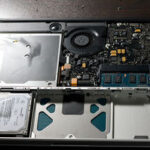Apple’s designers have an interesting habit of adding an “i” to everything that they make. Witness the iMac, iPod, and iPhone. Their first “i” product was the iMac, which looked like a neon gumdrop when it first came out, and the “i” stood for “Internet;” thus, the iMac was ostensibly the first computer designed for the Internet age.
The iMac was one of the first products designed (or redesigned) by Steve Jobs, who came back to Apple towards the close of the 20th century and scrapped a ton of their product lines, forcing them to simplify. Soon after its release they came out with a “consumer”-oriented laptop, the iBook. And the original iBook was brightly colored like the iMac, so that it would stand out against all the gray and beige PCs, but they soon released a new kind of iBook that ran Mac OS X and was solid white like today’s cheaper MacBooks.
Later on, they would decide that all their computers should have the word “Mac” in them somewhere. When this happened, the iBook became the MacBook, and the PowerBook became the MacBook Pro. So the iBook is basically the predecessor of today’s MacBooks. But what are the differences? Let’s find out!
Lower specs
Judging a computer by its specifications is something that PC users are more likely to do than Mac users. Still, when it was discontinued in 2006 the iBook was dramatically underpowered compared to today’s MacBooks. It had a tiny hard drive, and it could only get up to a little over a GB of RAM if you upgraded it.
In some ways, Apple intentionally crippled their iBook line to make the aluminum PowerBook line more appealing to “consumers” … or to make iBooks less attractive to creative professionals. According to this blog post (scroll about two-thirds of the way down) they had much slower processors than the Powerbook line, they couldn’t use an external monitor as a second display, and the 14″ iBooks had the same screen resolution as the 12″ ones. So “You got bigger pixels instead of more pixels.”
In other ways, such as exterior hardware design, the iBook was simply not as advanced. The keyboard and speakers look kind of cheap compared to those on today’s MacBooks, and while iBooks had solid designs and slot-loading CD drives they didn’t have a number of things today’s MacBook owners take for granted … like the MagSafe power adapter, or a latch-less clamshell design. On the other hand, they did have Firewire ports, which I’m given to understand that a number of modern Macs lack!
Different form factors
Basically, the iBook was available in a 12″ screen size, which was a bit smaller than today’s 13″ MacBooks and was as close as Apple has come to making a netbook or subnotebook computer. And instead of having a widescreen display like modern computers have, it had a more “square” display, with a 1024×768 resolution.
I could try to describe how iBooks look different from MacBooks, but why not just direct you to this YouTube video? The person narrating it will also point out some of the technical specs in a bit more detail than I’ve gone into. They kind of remind me of a sandwich, with that gray part in the middle.
Don’t get me wrong; iBooks were very advanced computers, and they still are today. They’re just not as advanced as a MacBook (although they are cheaper). And they’re arguably less attractive, although they’re still very nice! The smaller ones are very small, too.
Different processor architectures
This is where I have to get technical on you, so please bear with me. Modern Macs, the MacBook included, use Intel processors, like Intel Core 2 Duos. The iBooks, on the other hand, use “PowerPC” processors, like the G3 and G4 (meaning third- and fourth-generation respectively). Why were they called PowerPC processors when they were in Macs, and not PCs? Who knows. But that’s what they used back then.
These older processors are not compatible with Intel / AMD processor architectures. What that means is that software “compiled” to run on Intel or AMD processors won’t work on them … and what that means is that some newer programs and games won’t run on the older iBooks. Like Microsoft Windows. You know how you can install and run Microsoft Windows on a Mac using Boot Camp? Well, you can’t on the older iBooks.
Most people probably won’t see this as a problem. And for the ones who do, there’s an older product called Virtual PC that lets you run Windows in some kind of slowed-down virtualization mode on non-Intel, PowerPC Macs. I’ve never tried it, so I have no idea how well it works, but it isn’t sold new in stores anymore — Microsoft bought out the people who make it. You can probably find a used copy floating around on eBay somewhere, though.
The Upshot
Those are the differences between yesterday’s iBook and today’s MacBooks. And as time goes on, there are going to be even more … the new aluminum unibody MacBooks bear very little resemblance to the old iBooks, and in fact look more like the 14″ PowerBooks. Or a miniature MacBook Pro.
If you’re thinking of buying an older used iBook, make sure it’ll do everything that you need it to, first. What are you going to use it for, and what software will you need for it? If you don’t know or aren’t sure, try visiting some Mac forums and asking around. The people there will be able to point you to useful links.
Buying older, used computers is environmentally friendly; in fact, it’s sometimes the best form of recycling. It’s also cheaper, and in today’s economy we need to save all the money we can. Hopefully this article helped answer some of your questions about Apple’s older iBooks!





